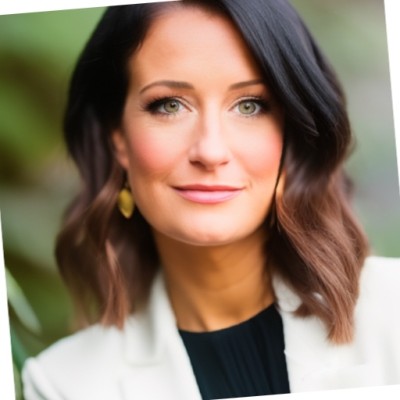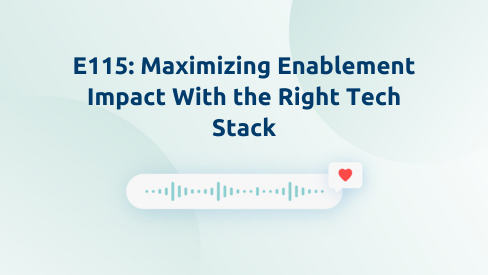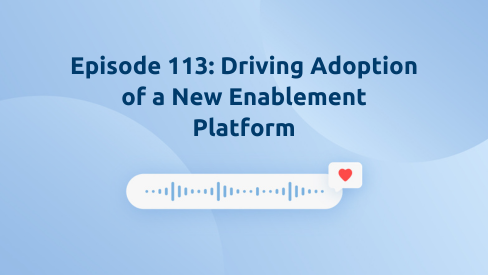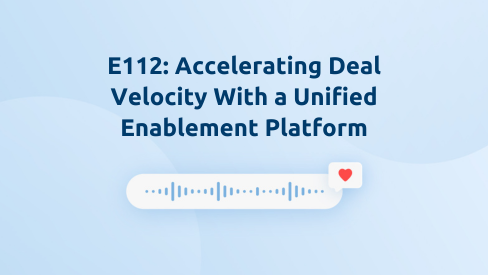Recent Highspot research of more than 500 global organizations revealed that by having a systematic approach to behavior change, you are 34% more likely to have enablement activities that are aligned with key business priorities. So how can you create a systematic approach to drive results through enablement?
Shawnna Sumaoang: Hi and welcome to the Win Win Podcast. I’m your host, Shawnna Sumaoang. Join us as we dive into changing trends in the workplace and how to navigate them successfully. Here to discuss this topic is Alexa Barden, growth enablement at Rapid7. Thanks for joining, Alexa! I’d love for you to tell us about yourself, your background, and your role.
Alexa Barden: Thank you so much, I am happy to be here. My name is Alexa Barden. I’ve served in a few different roles and fields post-college. I started out my career more in the special education realm. I’ve always had that knack for learning and enablement. Then I moved into various kinds of support, and account management roles, followed by training and development, and then finally where I am now, sales enablement.
From my educational background and my current enablement role, as I said, I’ve always had that deep passion and interest in the learner’s journey and their experience from start to finish. Being able to implement programs and see that full circle and full spectrum of the learners really being able to grasp that material and the content and the concepts behind it is all really super rewarding to me.
Specifically, my role at Rapid7 has also seen a few different faces, similar to my career. I began having a hand more so in our onboarding. through new hire facilitation, really helping to build out a global sales institute program, and then it moved into more of an ongoing project and program management type of role, where I’ll work with different stakeholders across the business to help better understand their needs across their segments and help to bring those to life.
Then the third part of my role which is kind of where Highspot really comes into play is focused around our enablement tooling and also a lot of the data in analytics that kind of live in those. I hope to extract that data from various sources and distill that down into a more digestible format for our leadership for my boss, for our team as a whole, to help kind of paint that full picture into, whatever that initiative is and how it’s doing and making sure it’s successful.
SS: I love that. You talked about the key components of your enablement strategy at Rapid7 and you talked a little bit about how Highspot helps you bring some of that to life, but are there other ways that Highspot helps you bring that strategy to life?
AB: Yeah, definitely. I would say beyond just being a content repository, and I think we’ll probably get into this as well, we are new customers of the Training and Coaching portion. Using now for a learning management system as well as content management, our reps are fully equipped and enabled and able to see everything in that single pane of glass view. They’re able to now have training mixed in with the everyday content that they’re looking at.
They can dive in and learn more about whatever that given topic might be pertaining to our products or our solutions. It’s really cool that our sellers are able to have that full integrative experience.
SS: Let’s talk about your own journey in enablement at Rapid7, because you touched on it again in your introduction, but you became the solution owner of Highspot about a year ago. Can you share a little bit about your journey over the past year?
AB: Yeah, definitely. I would say it wasn’t necessarily planned, but Highspot sort of fell in my lap and I am very happy about it. It was previously under another team member who was handling different aspects of onboarding and our commercial segment. Really having a dedicated and focused owner has been great since we specialize in specifically the needs within Highspot, enhancing the experience for our sellers, and really cleaning up that system.
No one had historically had the time to focus on it, so that became my focus. It’s really led me to form a passion and almost craft now for all things Highspot. I work with everything from the UX design, the spot and tagging structure, and doing deep dives into that analytics piece, so getting really detailed information on how our sellers are doing, what they’re looking at, what they’re clicking on, what they’re sending to prospects and customers, it’s been a huge help to our team to have a dedicated person really taking the time to focus on that.
SS: As a solution owner, you’ve made a lot of significant changes, including, as you mentioned a moment ago, implementing Training and Coaching and really reorganizing your Highspot instance. Can you tell us more about this evolution of your enablement journey with Highspot?
AB: It all started out with a lot of issues being surfaced when I moved over to really owning the system. One of the biggest ones I was seeing amongst our sellers was content findability, and to be candid, our system was a little messy. There were a lot of outdated materials in there. There was just a surplus of spots. There were a whole bunch of tags that weren’t necessarily being used. There weren’t really any governance policies in place. It did make it difficult for sellers to find what they needed both quickly and efficiently.
On top of this, there wasn’t necessarily a consistent look and feel across our spots, across our landing pages. It made it a little messy looking and overwhelming almost as if a little on our homepage and like I said, there wasn’t a lot of consistency there. All the banners looked a little bit different, headers and things like that. I would say the cohesion was also a little bit lacking. That was kind of what started me on my journey. How do we address some of these things to make the system, first of all, make us use it to its full potential and also make it a more pivotal and critical part of our seller’s day-to-day duties?
The first steps that I determined were needed was starting with essentially from a blank slate and doing a complete revamp of the system, meaning starting out with finding all of that outdated, low-value content that a lot of people weren’t looking at, and working to clear that out, get that clutter out of the way. That was the first step there, and then from there, it was a phased approach in terms of once everything was cleaned up making sure that we condensed it down, so it reduced the amount of spots, tags, and so on and so forth.
SS: Just to drill in a little bit on how you revamped your instance, I know that you guys went from having, as you mentioned, a substantial number of spots to a select few, which helped to improve findability. In fact, I think you guys now have 87% content findability, which is fantastic. How did this transformation help you improve the efficiency of your team?
AB: That reduction was a huge help because now it really comes down to three core areas that our sellers can go to find content, which are content related to any of our solution offerings, content related to our people and our processes, so the teams that our sales organization might interface with, and then also our latest kind of news, updates, recordings from our all hands sessions. If you’re looking for anything now, it’s only going to be in one of those three sections.
That really helped to eliminate that trial and error, that guessing. It’s making our reps less reliant on that aimless searching, just popping in any kind of word and seeing what comes up. Now that we’ve implemented those simple three spots, we’ve reduced our tags significantly.
We’re seeing that our reps are actually using those tags more if they’re looking for a specific product, they can just go click into that product tag and either go to a certain curated landing page or overview page for that tag, or they can just see that generic content view of everything pertaining to that specific tag. We’re seeing a lot less aimless or doom-searching, whatever you kind of want to call it, which is exactly what we were looking for. That’s one of the biggest improvements we’ve seen.
SS: That’s fantastic. We’ve talked about this a few times. I know that you recently implemented Highspot’s Training and Coaching capabilities. How are you planning on incorporating Highspot Training and Coaching into your onboarding and ongoing training programs?
AB: This is something we’re super excited about. We’re moving past that transitional phase of moving all of our content over and building out all of those learning pathways in the Training and Coaching instance. One of the drivers and things we’re most excited about is what I mentioned a little bit earlier, that full integrative experience and being able to surface key training right next to whatever collateral or sales deck or one pager it might be. They can easily go from learning about X in this one-pager to letting me go ahead and take this learning path about this as well to further my knowledge on the topic.
We’re also excited about the level of visibility we’ll be able to get now using Training and Coaching. With things like, scorecards coming up on the horizon, completion rates, progress, and things like that, we’re really looking forward to getting that full picture in one of everything together where you can see things like completion rates click volume, things like that on any particular page or piece of content to digital selling metrics, all in one single space.
We can really help to focus our managers and train them so they can use this information with their sellers to help them with coaching, and also so our team can make more informed decisions about what training is good and what we should issue more of, and maybe what training isn’t so great and we could cut back on. It’s really kind of a double-edged sword there where we can help out from a manager coaching standpoint and also as an enablement team to better inform our strategy moving forward.
That’s what we’re most excited about in terms of Training and Coaching and then specifically with our onboarding as well. One of the things that we’ve been working on specifically is to create learning paths for each of our roles now because the scope of enablement includes not only sellers but customer success, our support organization, and our sales engineers.
Helping to build out those more individualized or personalized pathways for all of those people in one unified, easily accessible location. That’s also what we’re really excited about to have that learning page and you can just jump quickly into your role-specific learning path, and I think that’s something we’re really excited to start building out in terms of our onboarding.
SS: Sounds amazing. You all already have an 89% recurring usage rate of the platform, which is incredible, and it shows that you guys are already seeing great results from all of the work that you’re doing to optimize your use of Highspot. Can you share some best practices for how you’ve driven adoption?
AB: I would say kind of the biggest driver for us at Rapid7 has been having very clear and concise communication with our go-to customer team kind of throughout the process from start to finish. Working to keep sellers in the loop about changes and also taking that time to educate and train on these changes and best practices really goes a long way, I found, as opposed to kind of just putting out an announcement in a newsletter or an email maybe having some breakout sessions or segment based sections to train up our users and make sure they’re also using the system most efficiently.
Another aspect I found that’s huge is having that executive buy-in from our leadership and having that trickle down and having them also really explain the why behind the importance of a tool such as Highspot. In our case, we’ve been getting our teams super excited about all of the AI capabilities coming out with Highspot, and we’ve been coining it as ‘technology as our teammate’. What that means to us is getting the tools to work for you, which is exactly what Highspot does. This allows us to free up time, free up resources, and as more capabilities come out with Highspot Copilot, we know there’s a huge opportunity to get managers more intertwined in their team’s day-to-day. Also potentially strengthen the relationships between not only manager to seller, but also enablement to the sellers as well.
In a long-winded answer that’s kind of how we work to drive adoption in those three areas is having that clear, concise communication having that executive buy-in, and then also phrasing it as something that’s new and exciting. Let’s talk about all of the new AI capabilities. Let’s talk about digital selling. Let’s talk about auto-generating descriptions and Highspot being able to answer your questions. I think helping to build that excitement is super important also.
SS: Technology as a teammate, that is perfect. What business results have you seen since implementing Highspot?
AB: We’ve touched on a couple of those, but as you mentioned, we’ve seen tremendous improvements in findability rates, as you noted, but just overall better user experience. Thinking about how our reps are actually going into the system, finding things and because our spots and our tags were narrowed down so significantly, this just left little room for guessing in terms of where something might live in the system. Our click paths are super simple. As I said, if you’re looking for something pertaining to one of those three topics, our solution offerings, our people in our process, or our latest news, there are only three areas you can go to.
It leaves little room for interpretation, for guessing and I found that limiting down in our instance and for our company and creating simplicity has been what’s driven those results the most. Keeping it simple, keeping it concise, making sure that we have a consistent governance policy in place, so there’s always stakeholders that we’re working with that are going in and reviewing things on a certain cadence to make sure that they’re still being used, that they’re still valuable, and if they’re outdated, making sure that they’re kind of just getting rid of them so they’re not cluttering up the system.
SS: Tell me, Alexa, what is next for you and your team as you continue to evolve your enablement journey with Highspot?
AB: Next for us is working pretty closely with our product marketers and what we’re really working to do is help to create almost a book or a specific area where we can have a ton of digital selling templates. Regarding both our products and parts of our sales process. There are easily accessible quick templates that our sellers can just grab at the ready and pop in whatever they need to customize to make the customer or prospect feel seen, feel heard, and make it a real curated experience for them while also still having those templates in the back end. It’s just a quick grab-and-go. If we’re in the discovery phase, let me go ahead and grab that discovery template.
That’s kind of where we’re headed. We’ll be doing a full launch of all of this together, so Training and Coaching best practices use cases. We already have some smaller cohorts in there right now, and we’re seeing great success with that, but when we roll out to the broader organization coming up at our sales kickoff, we’re really excited to do that in tandem with our new digital selling templates and also best practices with those. It can be kind of a big bundle all at once where we can create the hype for it and get people ready for this new age of digital selling.
SS: I love that, Alexa. Just because you brought up your SKO, how are you guys leveraging Highspot to support your sales kickoff?
AB: We always have a dedicated and curated landing page experience. Our kickoff so not only for scheduling, to have that outlined for folks because we are a global organization knowing when everything is going to be happening is super important, but also as a resource for everything kickoff. It is where all of our recordings can live. We can create different pathways for each type of topic that’s discussed or for each day, rather, and we’ve organized it in different ways in the past, but we always like to have that be our hub for all things kickoff and Highspot.
That’s just where our sellers know to go, where our stakeholders know to go. and it really creates that ease of use just for our users to feel confident in knowing what’s going to be discussed, getting that recording if they weren’t able to attend and also kind of additional resources as well, and kind of what’s up next, what’s to come. Having that all outlined in a curated hub has been super helpful for us and we’re looking to continue that moving forward as well.
SS: I know SKO is top of mind for a lot of folks right now.
AB: It’s that time of year for sure.
SS: Last question for you, Alexa, what advice do you have for others who are looking to enhance their enablement maturity journey with Highspot?
AB: I would say the biggest thing is to keep asking questions. I’m sure my account team, I’ve driven them nuts a handful of times, but that’s okay. Just keep asking. The more you know, the more you’re going to be able to improve the experience. Whether that be about reporting, best practices, using the system, about the visual user experience whatever you and your team are hoping to learn more about, don’t be afraid to ask.
The more you learn about the system and the more equipped you are, the better you’ll be at training your own teams on it as well. I can’t necessarily speak for all of the Highspot staff, as I mentioned, but my specific account team has been absolutely incredible throughout our Training and Coaching implementation. We’ve been meeting twice weekly, sometimes three times weekly, whatever it takes to kind of get the questions answered. They’re always there for us, and they’re awesome.
If they don’t know the answer, they’re finding it for us within a very short time window, which is great. That’s really what it is. It always just keeps asking questions because there’s never going to be too much knowledge you can have. It’s always going to help better prepare you. So always be learning.
SS: Thank you so much for joining us. I really appreciate it.
AB: Thank you so much for taking the time to speak with me. I love talking about Highspot. I could do it all day, so anytime you let me know.
SS: Thank you for listening to this episode of the Win Win podcast. Be sure to tune in next time for more insights on how you can maximize enablement success with Highspot.




